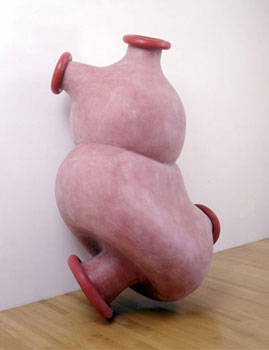
Continuing through December 30, 2011
In the broad sense, art in the 1970s was caught between rejecting Abstract Expressionism and having the conceptual savvy to sort through and extrapolate from its most profound innovations. Peter Shelton was in grad school during the ‘70s. A keen intellect and lovingly cantankerous renegade to his core, Shelton was told to avoid all traces of the NY School, like heroic size, sweeping angst. He responded with a career spent making works like “mouthheader,” and the stunning billows form titled “irondress.” Via their oft huge scale, their simply shaped evocation of the body vessel, their spatial inevitability and emotive charge, Shelton’s works converse with and at the same time thumb their nose at Pollock and the whole minimalist rule book that rendered him verboten.
Shelton’s current mini-retrospective “eyehand” spans works from the school years all the way to the present. Together with fascinating singular sculptures, Shelton presents what I call components — or objects that stand in their own right as compelling works but were conceived for or eventually found their way into Shelton’s impressive public projects.
Smartly riffing off and extending Ab Ex as well as ABC art traditions, Shelton manipulates constant yet indirect references to a body in action. His forms replace literal figuration, performativity (the viewer’s ability to see/feel the action of the artist’s process) and eccentric scale that exceeds sight habits and peripheral vision. What this does is extend the kinesthetic way Shelton invites us first into the work, so that our mind/memory take over. From deceptively simple repeating segments of tubes and hollows are engendered as many evocative associations and feelings as there are viewers.
In one of many conversations with Shelton over the years, I asked about ‘simple,’ shapes. His apt response: “Geeze, these are not simple.” “Simple” here refers more to an overt, quick-read simplicity that registers first viscerally - as weight, trajectory, density, mass, expansion, color and plane - all coming off as if in the process of ‘becoming.’ What one means by ‘becoming’ is both quite literal as well as poetic, best exemplified in a work like “dress,” with its non-illustrative but immediate references to the properties of embodiment: balance/teetering, harmony/disjuncture, growth/stasis, inside container/outside container, tactile/mental.
You will see here iterations of the complex abstract shape Shelton likes so much called a torus (basically a doughnut in 3-D). This was the shape that drove the Renaissance master of perspective Paolo Uccello wild (precisely because it can be spatially morphed into so many other essential shapes); it is the shape of certain internal body structures, the shape gases/energy/dust prefer when they gel up into maturing star systems. These are the rich allusions Shelton can pack into his ‘simple’ shapes that are, indeed, never actually simple.
The other excellent thing about this show is that its museum scope makes clear what a masterful draftsperson Shelton is, and that he has throughout his career carefully selected and mastered both precise realism (for example, all the playful, poignant objects from “thingsgetwet”), in addition to that pneumatic, segmented geometry we know him for — both used and mixed at will to perfection.
Published courtesy of ArtSceneCal ©2011
